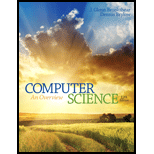
Computer Science: An Overview (12th Edition)
12th Edition
ISBN: 9780133760064
Author: Glenn Brookshear, Dennis Brylow
Publisher: PEARSON
expand_more
expand_more
format_list_bulleted
Concept explainers
Question
Chapter 11.4, Problem 5QE
Program Plan Intro
Evolutionary techniques:
This technique is used to produce the best machine for the upcoming generation from a multiple set of machines of old generations. The best attributes of the machine is chosen and are applied to the new generation machine to increase its efficiency.
Expert Solution & Answer
Want to see the full answer?
Check out a sample textbook solution
Students have asked these similar questions
Dijkstra's Algorithm (part 1). Consider the network shown below, and Dijkstra’s link-state algorithm. Here, we are interested in computing the least cost path from node E (note: the start node here is E) to all other nodes using Dijkstra's algorithm. Using the algorithm statement used in the textbook and its visual representation, complete the "Step 0" row in the table below showing the link state algorithm’s execution by matching the table entries (i), (ii), (iii), and (iv) with their values. Write down your final [correct] answer, as you‘ll need it for the next question.
4. |z + 5 - 5i| = 7
14.
dz,
C: |z❘
C: |z❘ = 0.6
ze² - 2iz
H
Chapter 11 Solutions
Computer Science: An Overview (12th Edition)
Ch. 11.1 - Prob. 1QECh. 11.1 - Prob. 2QECh. 11.1 - Prob. 3QECh. 11.1 - Prob. 4QECh. 11.1 - Prob. 5QECh. 11.2 - Prob. 1QECh. 11.2 - Prob. 2QECh. 11.2 - Prob. 3QECh. 11.2 - Prob. 4QECh. 11.2 - Identify the ambiguities involved in translating...
Ch. 11.2 - Prob. 6QECh. 11.2 - Prob. 7QECh. 11.3 - Prob. 1QECh. 11.3 - Prob. 2QECh. 11.3 - Prob. 3QECh. 11.3 - Prob. 4QECh. 11.3 - Prob. 5QECh. 11.3 - Prob. 6QECh. 11.3 - Prob. 7QECh. 11.3 - Prob. 8QECh. 11.3 - Prob. 9QECh. 11.4 - Prob. 1QECh. 11.4 - Prob. 2QECh. 11.4 - Prob. 3QECh. 11.4 - Prob. 4QECh. 11.4 - Prob. 5QECh. 11.5 - Prob. 1QECh. 11.5 - Prob. 2QECh. 11.5 - Prob. 3QECh. 11.5 - Prob. 4QECh. 11.6 - Prob. 1QECh. 11.6 - Prob. 2QECh. 11.6 - Prob. 3QECh. 11.7 - Prob. 1QECh. 11.7 - Prob. 2QECh. 11.7 - Prob. 3QECh. 11 - Prob. 1CRPCh. 11 - Prob. 2CRPCh. 11 - Identify each of the following responses as being...Ch. 11 - Prob. 4CRPCh. 11 - Prob. 5CRPCh. 11 - Prob. 6CRPCh. 11 - Which of the following activities do you expect to...Ch. 11 - Prob. 8CRPCh. 11 - Prob. 9CRPCh. 11 - Prob. 10CRPCh. 11 - Prob. 11CRPCh. 11 - Prob. 12CRPCh. 11 - Prob. 13CRPCh. 11 - Prob. 14CRPCh. 11 - Prob. 15CRPCh. 11 - Prob. 16CRPCh. 11 - Prob. 17CRPCh. 11 - Prob. 18CRPCh. 11 - Give an example in which the closed-world...Ch. 11 - Prob. 20CRPCh. 11 - Prob. 21CRPCh. 11 - Prob. 22CRPCh. 11 - Prob. 23CRPCh. 11 - Prob. 24CRPCh. 11 - Prob. 25CRPCh. 11 - Prob. 26CRPCh. 11 - Prob. 27CRPCh. 11 - Prob. 28CRPCh. 11 - Prob. 29CRPCh. 11 - Prob. 30CRPCh. 11 - Prob. 31CRPCh. 11 - Prob. 32CRPCh. 11 - Prob. 33CRPCh. 11 - What heuristic do you use when searching for a...Ch. 11 - Prob. 35CRPCh. 11 - Prob. 36CRPCh. 11 - Prob. 37CRPCh. 11 - Prob. 38CRPCh. 11 - Suppose your job is to supervise the loading of...Ch. 11 - Prob. 40CRPCh. 11 - Prob. 41CRPCh. 11 - Prob. 42CRPCh. 11 - Prob. 43CRPCh. 11 - Prob. 44CRPCh. 11 - Prob. 45CRPCh. 11 - Prob. 46CRPCh. 11 - Prob. 47CRPCh. 11 - Prob. 48CRPCh. 11 - Draw a diagram similar to Figure 11.5 representing...Ch. 11 - Prob. 50CRPCh. 11 - Prob. 51CRPCh. 11 - Prob. 52CRPCh. 11 - Prob. 53CRPCh. 11 - Prob. 54CRPCh. 11 - Prob. 55CRPCh. 11 - Prob. 56CRPCh. 11 - Prob. 57CRPCh. 11 - Prob. 1SICh. 11 - Prob. 2SICh. 11 - Prob. 3SICh. 11 - Prob. 4SICh. 11 - Prob. 5SICh. 11 - Prob. 6SICh. 11 - Prob. 7SICh. 11 - Prob. 8SICh. 11 - Prob. 9SICh. 11 - Prob. 10SICh. 11 - Prob. 11SICh. 11 - Prob. 12SICh. 11 - A GPS in an automobile provides a friendly voice...Ch. 11 - Prob. 14SI
Knowledge Booster
Learn more about
Need a deep-dive on the concept behind this application? Look no further. Learn more about this topic, computer-science and related others by exploring similar questions and additional content below.Similar questions
arrow_back_ios
SEE MORE QUESTIONS
arrow_forward_ios
Recommended textbooks for you
 Principles of Information Systems (MindTap Course...Computer ScienceISBN:9781285867168Author:Ralph Stair, George ReynoldsPublisher:Cengage Learning
Principles of Information Systems (MindTap Course...Computer ScienceISBN:9781285867168Author:Ralph Stair, George ReynoldsPublisher:Cengage Learning Principles of Information Systems (MindTap Course...Computer ScienceISBN:9781305971776Author:Ralph Stair, George ReynoldsPublisher:Cengage Learning
Principles of Information Systems (MindTap Course...Computer ScienceISBN:9781305971776Author:Ralph Stair, George ReynoldsPublisher:Cengage Learning Fundamentals of Information SystemsComputer ScienceISBN:9781337097536Author:Ralph Stair, George ReynoldsPublisher:Cengage Learning
Fundamentals of Information SystemsComputer ScienceISBN:9781337097536Author:Ralph Stair, George ReynoldsPublisher:Cengage Learning Systems ArchitectureComputer ScienceISBN:9781305080195Author:Stephen D. BurdPublisher:Cengage Learning
Systems ArchitectureComputer ScienceISBN:9781305080195Author:Stephen D. BurdPublisher:Cengage Learning Fundamentals of Information SystemsComputer ScienceISBN:9781305082168Author:Ralph Stair, George ReynoldsPublisher:Cengage Learning
Fundamentals of Information SystemsComputer ScienceISBN:9781305082168Author:Ralph Stair, George ReynoldsPublisher:Cengage Learning

Principles of Information Systems (MindTap Course...
Computer Science
ISBN:9781285867168
Author:Ralph Stair, George Reynolds
Publisher:Cengage Learning


Principles of Information Systems (MindTap Course...
Computer Science
ISBN:9781305971776
Author:Ralph Stair, George Reynolds
Publisher:Cengage Learning

Fundamentals of Information Systems
Computer Science
ISBN:9781337097536
Author:Ralph Stair, George Reynolds
Publisher:Cengage Learning

Systems Architecture
Computer Science
ISBN:9781305080195
Author:Stephen D. Burd
Publisher:Cengage Learning

Fundamentals of Information Systems
Computer Science
ISBN:9781305082168
Author:Ralph Stair, George Reynolds
Publisher:Cengage Learning